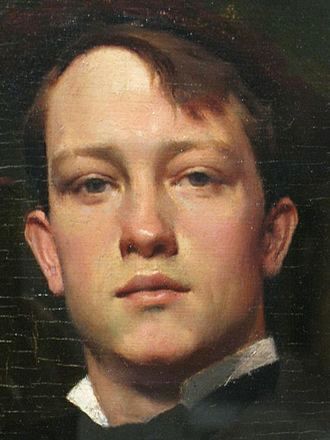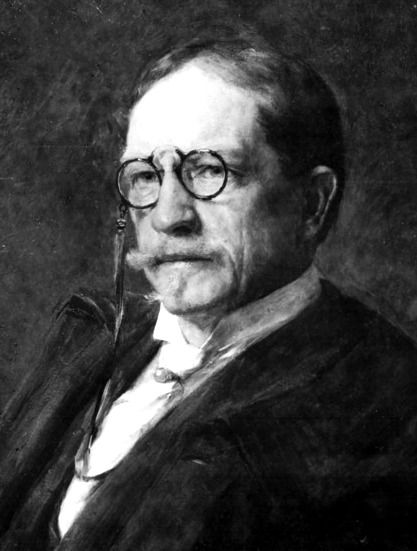Acquiring Walter Griffin's Autumn Poplars in 1951: a story
Walter Griffin (1861-1935) Autumn Poplars, Boigneville, 1911. Oil on canvas. Purchase from artist’s widow, Eleanor M. Proctor. 1952.8
At HMA's Annual Meeting on June 22, 2017, Griffin's 1911 Autumn Poplars, Boigneville (center above) was one of three paintings displayed to illustrate the threads of connections from Paul Whitener that still move through HMA's collection, reaching though Paul's own 1959 Autumn Leaves (on easel on right, his final completed painting before his death) to the recently (in 2016) acquired J.W. Etheredge's Woodland Scene. The following story of the acquisition of Autumn Poplars, Boigneville is derived from documents in HMA's files.
In early May of 1951, HMA’s exhibition year is winding down in Hickory as the summer heats up. Paul is still in his office in the white clapboard W.W.Bryan house on Third Avenue that was HMA’s home at that time. A lazy fan is stirring the air as Paul opens his mail, including a typed letter from New York City dated May 3, 1951 that reminds him that his mentor, teacher and benefactor Wilford Conrow continues to keep an eye out for the Museum’s interests.
The letter describes how Conrow has visited with the New York City art dealer Alon Dement who in turn is working with Walter Griffin’s widow Eleanor to sort out the warehoused remains of Griffin’s work. Alon and Eleanor have already marked for destruction about half of those canvases as being “detrimental to Griffin’s [artistic] reputation.” Conrow is appalled, and asks could he choose one of the best of the rejects for the Museum? Dement says sorry, no; but as he writes to Paul on May 3, “If I could induce Mrs. Proctor [she had re-married] to let you have one of the ones chosen as being good examples of his painting for $50, could you manage it?” (He means "does the Museum have the money?") Paul’s response is positive, as is Mrs. Proctor’s.
On June 20, 1951, Alon again writes to Paul, this time about shipping and payment details for Autumn Poplars, the work that Conrow chose for HMA. Alon also writes that “We here are quite crazy about this canvas, and we sincerely hope that you will feel that it will be admired as part of your museum collection.”
In July and August of 1951 the Museum is closed, as it continues to be during summers until the 1960’s. Paul and Mickey have retreated to what Paul calls his “summer studio” in Little Switzerland, North Carolina. Paul is still keeping track of Museum business, though the mails are slow and Paul’s attention is in the mountains where he paints every chance he can get.
On July 25th, however, Paul hand-writes Mrs. Proctor a four page letter of gracious enthusiasm about Autumn Poplars. He begins by apologizing for not writing sooner because of “having been just plain lazy. After a very strenuous year at the museum one feels the need for a period of seeming neglect of even important matters – such as the recognition of the generosity connected with the placement of the Walter Griffin painting in the Hickory Museum of Art.” He calls the work “a very moving painting.” He also expresses gratitude for the low price, which includes the frame.
HMA exhibited Griffin's painting multiple times in the 1980's and 1990's.
ABOUT WALTER GRIFFIN (1861-1935)
The American Impressionist painter Walter Parsons Shaw Griffin (pictured in a Dennis Miller Bunker 1881 painting and later in life in an unattributed photograph) was born in Portland, Maine where his father was a successful wood carver including of ship figureheads. Griffin began his formal art education In 1877 as a seventeen-year-old scholarship student at the School of the Museum of Fine Arts in Boston, and then went on to the National Academy of Design in New York City before moving to Paris in 1887.
Griffin lived and worked most of his adult life in Europe (France, Norway, Italy) and exhibited annually at the renowned Paris Salons. He interspersed his time in Europe with extended (years-long) stays in America, chiefly in Portland Maine but also in Connecticut; and by the late the 1890s he had opened the Walter Griffin's Summer Painting School in Quebec City, Canada. He was married the first time to the British-born American journalist and photographer Lillian Baynes Griffin (1871–1916), but they were divorced in 1908.
During his lifetime Griffin exhibited at all the finest American galleries, receiving tremendous critical acclaim and numerous awards. It was not unusual for him to sell as many as fifteen works at one exhibition. He had a resurgence of popularity in the 1970's and he has never totally gone out of style again.
More about Wilford Conrow here.
Post by Karin Borei, HMA Project Coordinator, writer and editor as needed, and HMA blogger since March 2015.






